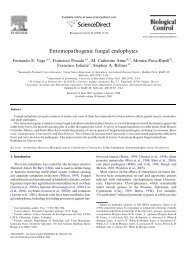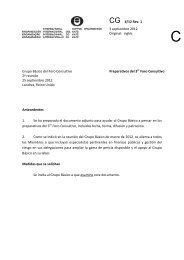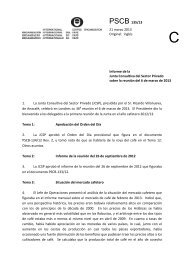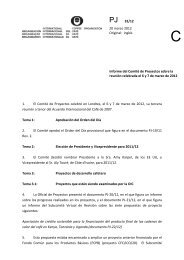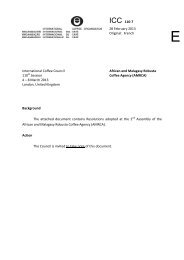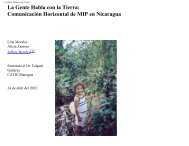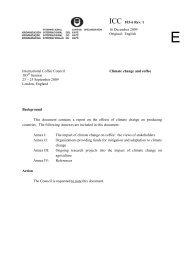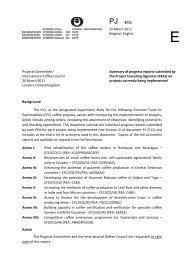Devouring profit - International Coffee Organization
Devouring profit - International Coffee Organization
Devouring profit - International Coffee Organization
Create successful ePaper yourself
Turn your PDF publications into a flip-book with our unique Google optimized e-Paper software.
national economy of Honduras. Between 1970 - 1987, coffee represented 37% of<br />
agricultural production growth, more than twice any other crop. Bananas were for a<br />
long time the primary exported product but after Hurricane Mitch, a substantial number<br />
of plantations were damaged, which are now recovering. This caused coffee exports<br />
to assume first place. Thus in 1998, coffee exports were US$433 million whilst for<br />
bananas for the same period the value was only US$157 million<br />
According to Oseguera 34 (2000), current productivity levels are a result of a project<br />
supported by USAID (Agency for <strong>International</strong> Development - US Government) 10<br />
years ago. This project focused on increasing coffee productivity based on new varieties,<br />
such as Catuai and augmentation of the density of trees per hectare from 1,700<br />
to 3,500. At that time IHCAFÉ lines of credit were supported by USAID, but currently<br />
all credit supplied to Honduran coffee is from the private sector. According to information<br />
from the Honduran <strong>Coffee</strong> Institute (IHCAFÉ), it is estimated that the total area<br />
planted in coffee crops is about 260,000 ha. The whole area is planted to arabica. The<br />
coffee areas are located from the centre to the northern and north-western parts<br />
which have a higher rainfall than the area to the south near El Salvador. Table 38 lists<br />
the different coffee regions in Honduras.<br />
Table 38. Principal coffee regions in Honduras.<br />
The average national coffee area per farm it is about 2.5 hectares with an estimated<br />
number of 105,000 coffee farmers. According to Suazo 35 (2000), 85% of the farmers<br />
have less than 5 hectares in coffee. But it is estimated that the other 15% are responsible<br />
for producing 45% of the country’s coffee with the remaining 85% of coffee<br />
farmers producing the other 55%, hence suggesting a considerable concentration of<br />
production in relatively few hands.<br />
Guatemala<br />
As in neighbouring Honduras, agriculture is the most important sector of the Guatemalan<br />
economy and one of its most important resources is its naturally fertile soil. Despite<br />
important mineral resources such as petroleum, antimony, lead, nickel, zinc, etc.,<br />
Guatemalan agriculture still provides about 25% of GDP. The most important agricul-<br />
34 Oseguera, F. Director of the Agricultural Division, IHCAFÉ. Personal Communication,<br />
2000<br />
35 Member of the technical staff, IHCAFÉ, Honduras, 2000<br />
101




